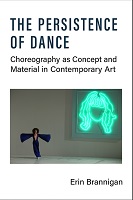The Persistence of Dance
External Review of Whole Manuscript
Choreography as Concept and Material in Contemporary Art
Abstract
There is a category of choreographic practice with a lineage stretching back to mid-20th century North America that has re-emerged since the early 1990s: dance as a contemporary art medium. Such work belongs as much to the gallery as does video art or sculpture and is distinct from both performance art and its history as well as from theater-based dance.
The Persistence of Dance: Choreography as Concept and Material in Contemporary Art clarifies the continuities and differences between the second-wave dance avant-garde in the 1950s‒1970s and the third-wave starting in the 1990s. Through close readings of key artists such as Maria Hassabi, Sarah Michelson, Boris Charmatz, Meg Stuart, Philipp Gehmacher, Adam Linder, Agatha Gothe-Snape, Shelley Lasica and Latai Taumoepeau, The Persistence of Dance traces the relationship between the third-wave and gallery-based work. Looking at these artists highlights how the discussions and practices associated with “conceptual dance” resonate with the categories of conceptual and post-conceptual art as well as with the critical work on the function of visual art categories. Brannigan concludes that within the current post-disciplinary context, there is a persistence of dance and that a model of post-dance exists that encompasses dance as a contemporary art medium.


 Download
Download